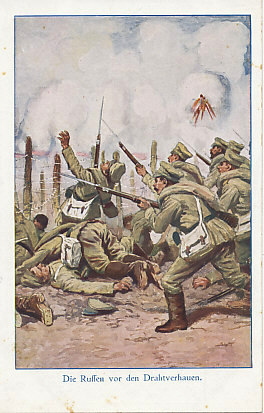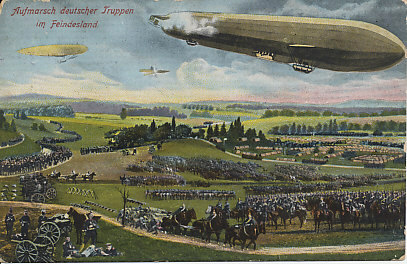|
Description |
Text |
Tags |
![A Turkish funeral with Turkish and German soldiers and officers attending and praying.
Text:
Türk[isches] Begräbnis
Turkish funeral](images/5851-75-dpi-Turkish-Funeral.jpg) more more |
A Turkish funeral with Turkish and German soldiers and officers attending and praying. Is this a young Mustapha Kemal praying? |
Türk[isches] Begräbnis
Turkish funeral |
Turkish funeral, funeral, coffin, 1915-11-22, Turkish soldier |
 more more |
Russian troops stopped by barbed wire. |
Die Russen vor den Drahtverhauen
The Russians in front of the barbed wire
Reverse:
Wohlfahrts-Postkarte
Der Reinertrag dient zum besten des deutsche Heeres
Der Auschuss:
Herzogin von Ratibor
Frau C. v Stumm, Frau Konf. Staudt
Dr. von Behr-Pinnow
Kammerherr S. M. des Kaisers
Kabinetsrat a. D. J. M. d. Kaiserin
J. Andreae, Bank-Director
Nr. 13
Verlag für Sozialpolitik, Berlin C19
Welfare Postcard
Net proceeds serve the best of the German Army
The Committee:
Duchess of Ratibor,
Mrs C. von Stumm, Women's Conference Staudt,
Dr. von Behr-Pinnow, Chamberlain of His Majesty the Emperor,
Cabinet Council retd. J. M. of the Empress
J. Andreae, Bank Director
No. 13
Publisher of Social Policy, Berlin C19 |
Russian offensive, barbed wire, Russian soldier |
 more more |
Grand Duchess Olga, eldest daughter to Tsar Nicholas II, inspecting her Hussar regiment before it leaves for the front. |
Czar's Oldest Daughter Inspecting her Regiment before it Leaves for the Front.
© Underwood & Underwood, N.Y.
23
Reverse:
The Grand Dutchess Olga, the Czar's oldest daughter Inspecting her regiment of Hussars, of which she is the Colonel, before it left for the front.
W.C.A. 145 |
Olga Romanoff, Olga Romanov, 1915-07-03, Hussar, 1914, 1915, Grand Duchess Olga |
 more more |
A stylish woman joins a line of Italian soldiers setting off. From a watercolor by Bianchi. |
signed: Bianchi |
Italy, soldier, mobilization, mobilize, Italian soldier, woman, 1915, 1915-07-01 |
 more more |
A German army advances in enemy territory, artillery, cavalry, and infantry deploying under the watchful and protective cover of airships and an airplane. The card was field posted on March 30, 1915. |
Aufmarsch deutscher Truppen im Feindesland
Deployment of German troops in enemy territory
Reverse:
Field postmark March 30, 1915 |
German troops, enemy territory, invasion, airship, 1915-06-28, invade, German army on the march |

